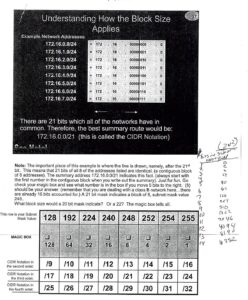Magic Box IP Subnetting
So a random discussion whilst I play Call of Duty:Black Ops was IP subnetting and the CCNA test. So IP subnetting, basic base 2 math, is actually very simple to accomplish. The tough part is trying to QUICKLY attain this information while testing.
I was taken back when I was asked how I did this during my 3 CCNA testing methods and Mike Storm, who was an instructor at Interface Technical Training in Phoenix AZ, had this awesome method called the Magic Box. His up beat training and encouragement was able to take something like IP Subnet Masks and broke it down for testing purposes so that when you get a question about how many hosts you have you fairly quickly know what subnet you need to work with.
This post expects you to have a base understanding of IP Subnetting and how things work. The understanding of what Classless-Inter Domain Routing Notation is, what subnet masks are, and the magical line that delineates from hosts to networks. With the basic understanding this magic box (when testing) makes understanding what is being asked in a quick format. *In most tests you have about 1 minute, or less, per question and when you stay on one for 5-10 minutes just trying to decipher some of it will throw you for a loop.
Enough of that mumbo jumbo lets get to the good stuff. Here is what Mike Storm taught me with the magic box –
So simple explanation is you essentially just need to KNOW the top row. From the top row you can fill in the rest easily.
- Notice that the top row corresponds with the various subnet masks most commonly utilized.
- 128,192,224,240,248,252,254, or 255. The \”octet\” determines the CIDR notation. Meaning if it is in the Second Octet it will be a /9 /10 /11 /12 /13 /14 /15 /16 respectively.
- Small side note – These \”slash numbers\” e.g. slash 16 equals the number of bits in the subnet mask in use between the network, Subnet, and host. /16 would be – X= number, n= network, and h = host xnnnnnnn.xnnnnnnn.hhhhhhhh.hhhhhhhh in binary. If you are in a class B subnet the first two octets are the only ones in concern for network addressing.
- The CIDR notation can then be deciphered, say if you get asked if Network B has a /25 network yet needs 700 hosts what network would support the required number of hosts… quickly (if you wrote this down) you can answer the question. If you aren\’t using a quick method then you are figuring it out from scratch; unless you are a quick with binary to convert back to decimal to determine the networks and hosts that can support such a network.
- With that same question – /25 network and 700 hosts doesnt work. Why because you look at what /25 is and you look up in the column and see that the network is split into two 128 segments which cannot handle 700 hosts. Most people should realize that a /24 is a 256 node network (0 through 255 = 256) and through the removal of the broadcast address and network address total usable nodes equals 254.
- ***NOTE the equation 2N-2 to determine actual host count… this removes the broadcast and network addresses from \”usable\” range which in turn gives you the actual numbers available.***
- 128,192,224,240,248,252,254, or 255. The \”octet\” determines the CIDR notation. Meaning if it is in the Second Octet it will be a /9 /10 /11 /12 /13 /14 /15 /16 respectively.
There are a ton of articles about how to subnet / put things down / figure things out but this magic box (when testing) makes it very simple to remember all the variations quickly. I\’ve used it 2 times on the 3 times I have passed my CCNA combined test (one test to get the CCNA) and helped me save time on a few questions.
Hope you like this and happy subnetting!!
IP Subnetting from cisco – http://www.cisco.com/en/US/tech/tk365/technologies_tech_note09186a0080093f33.shtml

